| Otterhound | |||||||||||||||||||||||||||||
|---|---|---|---|---|---|---|---|---|---|---|---|---|---|---|---|---|---|---|---|---|---|---|---|---|---|---|---|---|---|
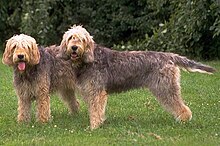 Otterhounds | |||||||||||||||||||||||||||||
| Origin | England | ||||||||||||||||||||||||||||
| |||||||||||||||||||||||||||||
| |||||||||||||||||||||||||||||
| Dog ( domestic dog ) | |||||||||||||||||||||||||||||
The Otterhound is an English dog breed. It is a scent hound and is currently recognised by the Kennel Club as a Vulnerable Native Breed with around 600 animals worldwide. [1] [2]
| Otterhound | |||||||||||||||||||||||||||||
|---|---|---|---|---|---|---|---|---|---|---|---|---|---|---|---|---|---|---|---|---|---|---|---|---|---|---|---|---|---|
 Otterhounds | |||||||||||||||||||||||||||||
| Origin | England | ||||||||||||||||||||||||||||
| |||||||||||||||||||||||||||||
| |||||||||||||||||||||||||||||
| Dog ( domestic dog ) | |||||||||||||||||||||||||||||
The Otterhound is an English dog breed. It is a scent hound and is currently recognised by the Kennel Club as a Vulnerable Native Breed with around 600 animals worldwide. [1] [2]
The first recorded Otterhounds known to resemble the current breed are in the North-West of England in the first half of the 19th century – for example, the Hawkstone Otter Hunt and Squire Lomax's Otterhounds. In the second half of the 19th century, French Griffons were outcrossed, including one-eighth Wolf cross/Griffon Vendéen from the Comte de Canteleu in Normandy. [3] [4] In the early 20th century the Griffon Nivernais was crossed into the breed, and one particular dog, Boatman, a Grand Griffon Vendéen/Bloodhound cross, became an ancestor for several kennels. [5]
The Otterhound is a large, rough coated, and straight limbed dog. The head is deep but not wide with the rough coat giving it a beard or moustache of sorts. The nose is wide. The eyes are deep set with the haw only slightly showing. The ears are long and pendulous, they roll inwards as to create a 'drape' appearance. The neck is long a slight dewlap is allowed. The forelegs are straight from the elbow to the ground. Pasterns are slightly strung. Hind legs are well-muscled with heavily muscled thighs, in a normal stance the hind legs from hock to ground are perpendicular. Feet are large, round, and thick padded. The tail is thick at the base and never curls over the back. The coat is 4-8 cm (1½-3 inches) in length, dense, rough, and waterproof; appears broken. Height at the shoulder is 69 cms (27 inches) for dogs and 61 cms (24 inches) for bitches. [6] Otterhounds generally weigh between 80 and 115 pounds (36 and 52 kg). [7]
Recognised colours are: whole coloured, grizzle, sandy, red, wheaten, and blue; with white markings permissible in all of them as well as lemon, blue, or badger pied markings. [6]

Otter hunting dates back to the early medieval period, with references to it found as early as 1360. The otterhound, however, can only be traced back as a distinct breed as far as the early 1800s.[ citation needed ]
To be equal to the otter, an Otterhound was said to need "a Bulldog's courage, a Newfoundland's strength in water, a Pointer's nose, a Retriever's sagacity, the stamina of a Foxhound, the patience of a Beagle, and the intelligence of a Collie [8] ".
This article or section appears to contradict itself.(February 2024) |
In 1978, due to the dramatic decline in otter numbers, the otter was placed on the list of protected species in Britain, and otter hunting therefore ceased.[ citation needed ] It was never banned in Britain, the otter hunts stopped hunting voluntarily, as it was they who realised that otter numbers were dropping dramatically and brought it to the attention of the authorities.[ citation needed ] By 1977, nine registered packs of otterhounds were still in existence. A few hunts switched to hunting mink or coypu, but many of the original otterhound packs ceased to exist altogether. Hounds were often passed to newly founded minkhound packs. The Pembroke and Carmarthenshire Minkhounds are the only pack today with a pure otterhound pack. As the dogs had been selectively bred for their hunting capabilities, only a few of the bloodlines were suitable for breeding into companion animals. [5]
A survey of breed club members in the UK found a life expectancy of 10.21 years. [9] The same survey identified a predisposition to gastric dilatation volvulus with 9% of Otterhounds having the condition and 7.4% of deaths attributable to the condition. [10]
In 2012 it was estimated there were around 600 otterhounds in the world. It is considered to be the most endangered native breed in Britain, with only 41 new registrations in 2016. [1] This is partly because otterhounds have never been numerous, and even in the early 20th century, when otter hunting as a sport was at the height of its popularity, the number of dogs was still small. They are on the list of Vulnerable Native Breeds as identified by the UK Kennel Club, and great efforts are being made to save the breed. [11]

The Scottish Deerhound, or simply the Deerhound, is a breed of large sighthound, once bred to hunt the red deer by coursing. In outward appearance it is similar to the Greyhound, but larger and more heavily boned, with a rough coat.

A hound is a type of hunting dog used by hunters to track or chase prey.

The Basset Hound is a short-legged breed of dog in the hound family. The Basset is a scent hound that was originally bred for the purpose of hunting hare. Their sense of smell and ability to ground-scent is second only to the Bloodhound.

The Great Dane is a German breed of large mastiff-sighthound, which descends from hunting dogs of the Middle Ages used to hunt bears, wild boar, and deer. They were also used as guardian dogs of German nobility. It is one of the two largest dog breeds in the world, along with the Irish Wolfhound.

Scent hounds are a type of hound that primarily hunts by scent rather than sight. These breeds are hunting dogs and are generally regarded as having some of the most sensitive noses among dogs. Scent hounds specialize in following scent or smells. Most of them tend to have long, drooping ears and large nasal cavities to enhance smell sensitivity. They need to have relatively high endurance to be able to keep track of scent over long distances and rough terrain. It is believed that they were first bred by the Celts by crossbreeding mastiff-type dogs with sighthounds. The first established scent hounds were St. Hubert Hounds bred by monks in Belgium during the Middle Ages.
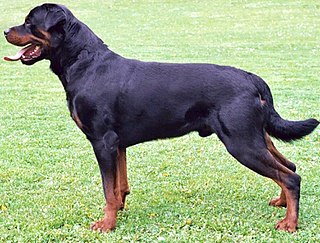
The Rottweiler is a breed of domestic dog, regarded as medium-to-large or large. The dogs were known in German as Rottweiler Metzgerhund, meaning Rottweil butchers' dogs, because their main use was to herd livestock and pull carts laden with butchered meat to market. This continued until the mid-19th century when railways replaced droving. Although still used to herd stock in many parts of the world, Rottweilers are now also used as search and rescue dogs, guard dogs, and police dogs.

The Newfoundland is a large breed of working dog. They can be black, grey, brown, or black and white. However, in the Dominion of Newfoundland, before it became part of the confederation of Canada, only black and Landseer (white-and-black) coloured dogs were considered to be proper members of the breed. They were originally bred and used as working dogs for fishermen in Newfoundland.

The German Wirehaired Pointer is a medium to large-sized griffon type breed of dog developed in the 19th century in Germany for versatile hunting. It became a leading gun dog in Germany in the later part of the 20th century. It is the result of the careful mixing and crossing of the Wirehaired Pointing Griffon, German Shorthaired Pointer, German Roughhaired Pointer, and the hunting Pudelpointer in the late 19th century.

The Basset Fauve de Bretagne is a short-legged hunting breed of dog of the scent hound type, originally from Brittany, a historical duchy of France.

The Grand Basset Griffon Vendéen or GBGV is a dog breed from France.
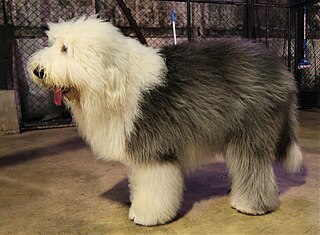
The Old English Sheepdog is a large breed of dog that emerged in England from early types of herding dog. Obsolete names for the breed include Shepherd's Dog and bob-tailed sheep-dog. The nickname Bob-tail originates from how dogs of the breed traditionally had their tails docked. Old English Sheepdogs can grow very long coats with fur covering the face and eyes and do not shed unless brushed.

The Cane Corso is an Italian breed of mastiff. It is usually kept as a companion dog or guard dog; it may also be used to protect livestock. In the past it was used for hunting large game, and also to herd cattle.

The Petit Basset Griffon Vendéen, or PBGV, is a breed of dog of the scent hound type, bred to trail hares in bramble-filled terrain of the Vendée district of France. The breed is known in the United States as "Petit" or "PBGV," in England as "Roughie," and in Denmark as "Griffon" or "Petit". The PBGV is one of six types of "basset"-type breeds recognised by the Fédération Cynologique Internationale (FCI).

The Dobermann is a German breed of medium-large domestic dog of pinscher type. It was originally bred in Thuringia in about 1890 by Louis Dobermann, a tax collector. It has a long muzzle and – ideally – an even and graceful gait. The ears were traditionally cropped and the tail docked, practices which are now illegal in many countries.
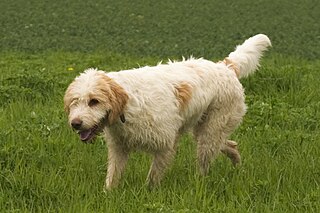
A Briquet Griffon Vendéen is a medium-sized griffon scenthound originating in Vendeé, France. The Briquet Griffon Vendéen was recognized by the FCI in 1954.

The Basset Bleu de Gascogne, also known as the Blue Gascony Basset, is a long-backed, short legged breed of dog of the hound type. A French native breed, it is rare outside its homeland. It is recognized internationally by the Fédération Cynologique Internationale, in the UK by The Kennel Club, and by the United Kennel Club in the United States. The "bleu" of its name is a reference to its coat which has a ticked appearance.

The Basset Artésien Normand is a short legged hound type dog developed in France. The word basset refers to short-legged hounds.
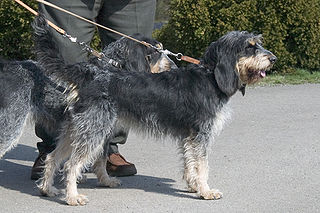
The Griffon Bleu de Gascogne is a breed of dog of the scenthound type, originating in France, and is a versatile hunting dog, used on small and large game, in packs or individually. The Griffon Bleu de Gascogne has a speckled, rough coat.

The Griffon Nivernais is a breed of dog of the scenthound type, originating in France. It is a versatile hunting dog, used on small and large game, in packs or individually. Today's breed is a reconstruction of an ancient type of dog from the Nivernais region.

The Griffon Fauve de Bretagne is a breed of dog of the scenthound type, originating in France in the region of Brittany.
![]() Media related to Otterhound at Wikimedia Commons
Media related to Otterhound at Wikimedia Commons